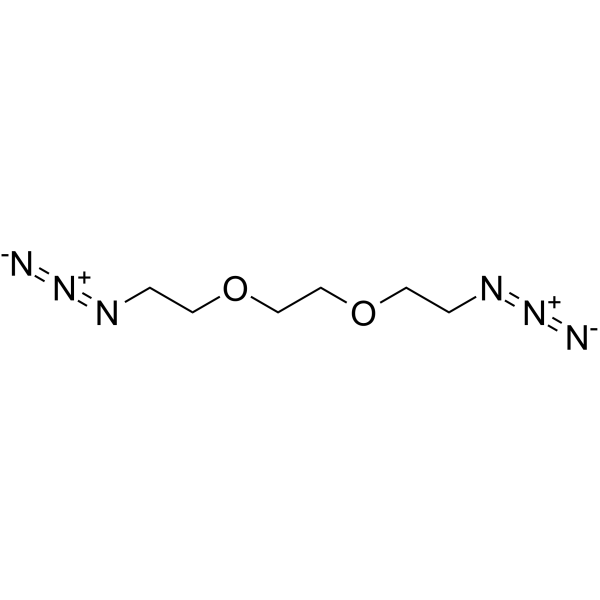
Azido-PEG2-azide
CAS No. 59559-06-7
Azido-PEG2-azide( —— )
Catalog No. M26895 CAS No. 59559-06-7
Azido-PEG2-azide is a PEG-based PROTAC linker that can be used in the synthesis of PROTACs.
Purity : >98% (HPLC)
 COA
COA
 Datasheet
Datasheet
 HNMR
HNMR
 HPLC
HPLC
 MSDS
MSDS
 Handing Instructions
Handing Instructions
| Size | Price / USD | Stock | Quantity |
| 25MG | 27 | Get Quote |


|
| 100MG | Get Quote | Get Quote |


|
| 200MG | Get Quote | Get Quote |


|
| 500MG | Get Quote | Get Quote |


|
| 1G | Get Quote | Get Quote |


|
Biological Information
-
Product NameAzido-PEG2-azide
-
NoteResearch use only, not for human use.
-
Brief DescriptionAzido-PEG2-azide is a PEG-based PROTAC linker that can be used in the synthesis of PROTACs.
-
DescriptionAzido-PEG2-azide is a PEG-based PROTAC linker that can be used in the synthesis of PROTACs.(In Vitro):PROTACs contain two different ligands connected by a linker; one is a ligand for an E3 ubiquitin ligase and the other is for the target protein. PROTACs exploit the intracellular ubiquitin-proteasome system to selectively degrade target proteins.
-
In VitroPROTACs contain two different ligands connected by a linker; one is a ligand for an E3 ubiquitin ligase and the other is for the target protein. PROTACs exploit the intracellular ubiquitin-proteasome system to selectively degrade target proteins.
-
In Vivo——
-
Synonyms——
-
PathwayOthers
-
TargetOther Targets
-
RecptorIRAK-1
-
Research Area——
-
Indication——
Chemical Information
-
CAS Number59559-06-7
-
Formula Weight200.2
-
Molecular FormulaC6H12N6O2
-
Purity>98% (HPLC)
-
SolubilityIn Vitro:?DMSO : 100 mg/mL (499.50 mM)
-
SMILES[N-]=[N+]=NCCOCCOCCN=[N+]=[N-]
-
Chemical Name——
Shipping & Storage Information
-
Storage(-20℃)
-
ShippingWith Ice Pack
-
Stability≥ 2 years
Reference
1.Powers JP, et, al. Discovery and initial SAR of inhibitors of interleukin-1 receptor-associated kinase-4. Bioorg Med Chem Lett. 2006 Jun 1;16(11):2842-5.
molnova catalog



related products
-
3-Hydroxybenzaldehyd...
3-Hydroxybenzaldehyde is a compound useful in organic synthesis.
-
Lapisteride
Lapisteride (CS-891) a steroidal 5α-reductase inhibitor is used to treat benign prostatic hyperplasia (BPH) and androgenetic alopecia and may be effective in preventing or treating AGA .
-
Oxyphyllacinol
Oxyphyllacinol has antidiarrheal activity.Oxyphyllacinol has been shown to treat dementia. Oxyphyllacinol was isolated from the S. nodiflora water fraction, while the S. nodiflora water fraction has been shown to have antioxidant and anti-aging activities, inducing mitochondrial activity and increasing ctt1 gene expression by regulating stress tolerance response.



 Cart
Cart
 sales@molnova.com
sales@molnova.com


